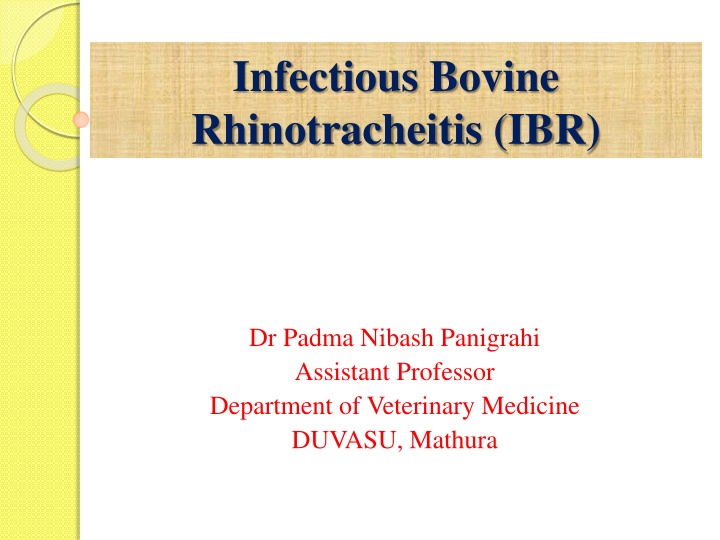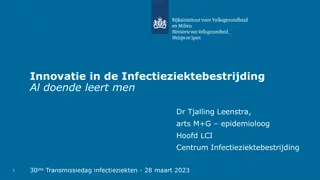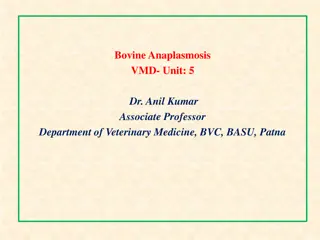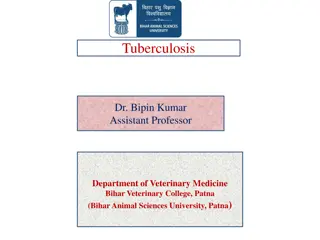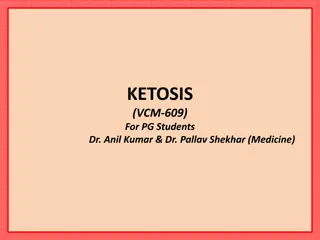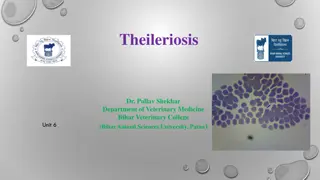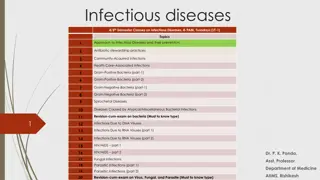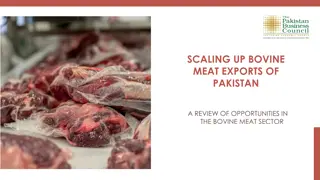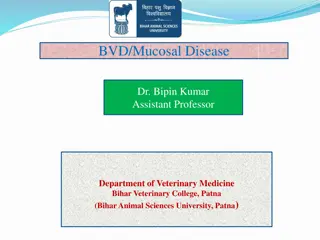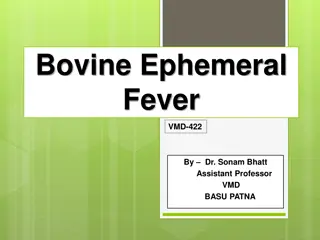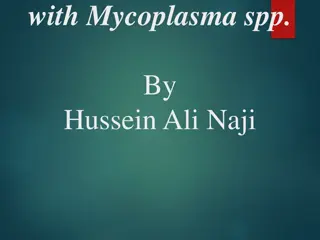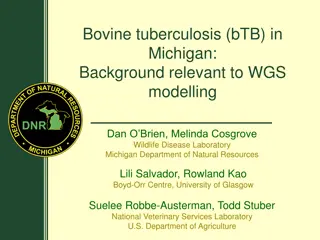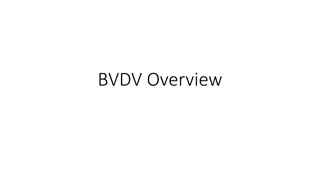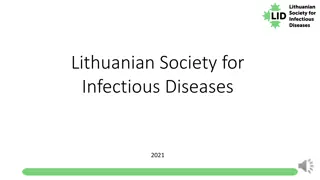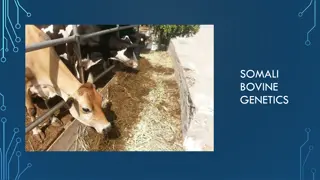Infectious Bovine Rhinotracheitis (IBR)
Infectious Bovine Rhinotracheitis (IBR) is a viral disease affecting cattle, buffaloes, and wild ruminants, caused by Bovine herpesvirus. It has various forms, including respiratory, genital, and encephalitic, with different methods of transmission. Clinical signs include rhinitis, tracheitis, conjunctivitis, anorexia, pyrexia, and respiratory distress. Understanding the epidemiology, morbidity, and case fatality rates of IBR is essential for effective management and prevention strategies.
Download Presentation

Please find below an Image/Link to download the presentation.
The content on the website is provided AS IS for your information and personal use only. It may not be sold, licensed, or shared on other websites without obtaining consent from the author.If you encounter any issues during the download, it is possible that the publisher has removed the file from their server.
You are allowed to download the files provided on this website for personal or commercial use, subject to the condition that they are used lawfully. All files are the property of their respective owners.
The content on the website is provided AS IS for your information and personal use only. It may not be sold, licensed, or shared on other websites without obtaining consent from the author.
E N D
Presentation Transcript
Infectious Bovine Rhinotracheitis (IBR) Dr Padma Nibash Panigrahi Assistant Professor Department of Veterinary Medicine DUVASU, Mathura
Etiology Alfa herpesviridae subtypes Bovine herpes virus-l BHV-l .l (respiratory) BHV-l.2a and 1.2b(genital) BHV- l.3 (BHV-5; encephalitic)
Epidemiology Occurrence: Asia, Africa, Europe, North America, Australia, News Zealand Host: cattle, buffaloes, small ruminant, wild ruminants Endemic in white-tailed deer in certain parts of Canada, wild and farmed red deer in Britain Buffaloes & wild ruminants may reservoir host
Morbidity & case fatality: Uncomplicated form of the respiratory disease in cattle is not highly fatal most losses being due mainly to secondary bacterial bronchopneumonia. The morbidity and case fatality rates in dairy cattle are about 8% and 3% feedlot cattle the morbidity rate is usually 20-30% in unvaccinated
Methods of transmission Respiratory form: droplet, nasal secretion Genital form: semen, genital fluid, foetal fluid, venereal Risk factor All ages and breeds of cattle are susceptible most common- above 6 months of age (probably because of their greater exposure) Unvaccinated herd -breeding cattle are highly susceptible to epidemics of respiratory disease and abortion
Clinical signs Respiratory, Rhinitis (red nose) Ocular form Abortive form (IPV) Systemic disease in newborn calves Encephalitic form
Rhinitis, tracheitis and conjunctivitis (red nose) Anorexia, pyrexia (up to 42 C, 108 F) Salivation Nasal and ocular discharge loud coughing severe hyperemia of the nasal mucosa Severe (viral or secondary bacterial) tracheitis, Inspiratory dyspnoea abnormal tracheal breath sounds Respiratory distress is evident on exercise
Ocular form Conjunctivitis Conjunctiva- reddened and edematous Profuse serous ocular discharge (DD: infectious keratoconjunctivitis (pink eye) IBR lesions: confined to the conjunctiva and there are no lesions of the cornea except diffuse edema Calves below 6 months of age may develop encephalitis, incoordination, Excitement, depression, Salivation, bellowing, convulsions and blindness high mortality rate.
Systemic disease in newborn calves newborn calves under 10 days of age highly fatal Sudden anorexia, fever excessive salivation rhinitis unilateral or bilateral conjunctivitis Bronchopneumonia loud breath sounds, crackles and wheezes Outbreaks- unvaccinated herd (dams)
Abortion (IPV) 6-8 month of pregnancy Retention of placenta Endometritis Infectious vulvo vaginitis Short estrous Infertility
NECROPSY FINDINGS Adult cattle- tracheitis, bronchitis Pulmonary emphysema or bronchopneumonia, Profuse and fibrinopurulent exudates Lymph nodes: throat and neck region are usually swollen and edematous Aborted fetuses: autolysis and focal necrotizing hepatitis
Rhinitis with congested nasal chambers drag_rao@yahoo.com Special Pathology-I (VPP-511) 13
Tracheitis (IBR) drag_rao@yahoo.com Special Pathology-I (VPP-511) 14
CLINICAL PATHOLOGY Histology formalin-fixed samples: abortion/neonate: lung, liver, trachea, kidney, adrenal gland, rumen, esophagus, pharynx; respiratory form: nasal turbinate, trachea, pharynx, lung encephalitic form: half of mid sagittally sectioned brain Virology - abortion/neonate: lung, liver, kidney, rumen respiratory form: lung, trachea, nasal swab Encephalitic form: half of midsagittally-sectioned brain (FAT, PCR)
Isolation of virus Cell lines - Madin Darby bovine kidney cell line (MDBK) uesd for BoHV-1 propagation Virus isolation from semen (a prescribed test for international trade) Nucleic acid detection DNA DNA hybridisation and the PCR Real-time polymerase chain reaction (a prescribed test for international trade)
Viral antigen detection Nasal, ocular or genital swabs can be directly smeared onto glass cover-slips direct or indirect fluorescent antibody test ELISA VNT
Treatment No specific anti viral drug Broad-spectrum antimicrobials are indicated if secondary bacterial tracheitis and pneumonia are present OTC, Ceftriazone, Ceftiofur, Enrofloxacin Bronchodilator: Deriphylline Inhailation NSAID Supportive therapy
Control Vaccination Biosecurity Hygiene Isolation and quarrantine
Vaccination (6-12 months of age) 1. Modified live-virus vaccines (2 types) parenteral vaccine usually made with bovine foetal kidney tissue culture intranasal vaccine of rabbit tissue culture origin An intranasal vaccine of bovine tissue culture origin containing a temperature-sensitive mutant is also available Protection from infection and disease has been observed within 40-96 hours following vaccination
2. Inactivated vaccine require two doses of the vaccine Booster- 10-14 days after the primary But protection is observed after 7-10 days following the second dose of vaccine
.3. Subunit vaccines contains only one or more of the antigens of the pathogen necessary to evoke protective immunity, and lacks the components that might cause unwanted side-effects. Contain major surface glycoproteins of the BHV-1
Vaccination programs in herds Beef breeding herds. Beef calves -2-3 weeks before weaning Heifer and bull -at least 2 weeks before breeding Dairy cattle heifer 2-3 weeks before breeding.
